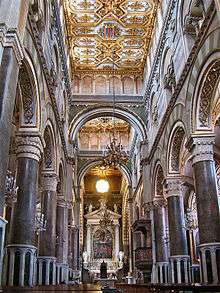Altamura Cathedral


Altamura Cathedral (Italian: Duomo di Alamura, Cattedrale di Santa Maria Assunta), dedicated to the Assumption of the Blessed Virgin Mary, is a Roman Catholic cathedral in the city of Altamura, in the province of Bari, Apulia, in southern Italy.
Since 1986 it has been the seat of the Bishop of Altamura-Gravina-Acquaviva delle Fonti, formed in that year. Previously it was the church of the territorial prelature of Altamura (from 1848, Altamura e Acquviva delle Fonti).
It was built by Emperor Frederick II in 1232, and became one of the most venerated sanctuaries in Apulia. In 1248, under pressure from Frederick, Pope Innocent IV declared Altamura exempt from the jurisdiction of the bishop of Bari, making it a "palatine" church, one of four in Apulia.[1]
According to some local historians of the past, Altamura Cathedral was built on the area of a pre-existing pagan temple. Domenico Santoro (1688) hypothesizes that it may have been a temple dedicated to Castor and Pollux,[2] since on the capitols of the chorus two statues of Castor and Pollux were present at least until the XVIII century. Then, they were destroyed.[3] Recent archaeological excavations have confirmed the influence of Magna Grecia in the area of the city of Altamura, in particular in the period between the IV and III centuries BC. [2] D. Vitangelo Frizzale (1755), instead, states that it was a temple devoted to Janus (Latin: Ianus bifrons), a Roman deity. Some authors believe that this information is confirmed by the presence, in the past, of a two-faced herm on the cusp of the Cathedral's ancient façade.[4]

An inscription in Latin, located upon the so-called "Angevin door" (Italian: porta angioina), says that the church collapsed on January 29, 1316 and that it was rebuilt with the help of skilled constructors from the nearby city Bitonto. The first man who correctly translated this inscription was local historian Ottavio Serena, as he stated in his work Storia di Altamura. Previous historians incorrectly translated the inscription (which was hard to read and written in bad Latin) and they thought that the inscription referred to a privilege that Altamura benefited, according to which every year Bitonto's mayor used to come to Altamura to take the price list of the foods and to spread it to the whole province.[5]
The current orientation of the church is opposite to the original one, although it is not known if the change dates to Robert of Anjou's reign (early 14th century) or to the enlargement carried out in 1521-1547. The northern portal dates from Robert's time, while the second bell tower, the altar area and the sacristy were added in the 16th century. From the 18th century are the upper parts of the two bell towers and the small loggia between them.
In 1858 (just three days before the Unification of Italy), the clock tower was added (designed by architect Corradino de Judicibus).[6]

Restoration
Altamura Cathedral has been recently restored.[7] The external restoration works, carried out in the period July-November 2006 by Italian company Cobar S.p.a have restored the external walls of the cathedral to their original white color.[8]

Another restoration work has been carried out in 2017 for the floor, the lighting system, the three entrance portals and other wooden structures.[9]
References
- ↑ Palatine churches were exempt from episcopal jurisdiction, and came instead under that of the sovereign, who usually nominated and paid their clergy. The other three palatine churches in Apulia were Acquaviva Cathedral, the Basilica of San Nicola in Bari and the church of Monte Sant'Angelo sul Gargano.
- 1 2 T. Berloco (1985), p. 22, note 13
- ↑ T. Berloco (1985), p. 39, note 44
- ↑ T. Berloco (1985), p. 116, note 5
- ↑ T. Berloco (1985), p. 182
- ↑ http://prolocoaltamura.it/it/tag/personaggi-it/
- ↑ https://www.altamuralife.it/notizie/la-cattedrale-restituita-al-sua-antico-splendore/
- ↑ http://www.cobargroup.it/restauro/cattedrale-di-altamura/
- ↑ https://www.altamuralife.it/notizie/la-cattedrale-restituita-al-sua-antico-splendore/
Sources
| Wikimedia Commons has media related to Cathedral (Altamura). |
- Blanchard, Paul, 1990: Southern Italy from Rome to Calabria: The Blue Guides, 7th edn., p. 345. London: A & C Black
- Berloco, Tommaso (1985). Storie inedite della città di Altamura (in Italian). ATA - Associazione Turistica Altamurana Pro Loco.
Coordinates: 40°49′39″N 16°33′11″E / 40.82741°N 16.55311°E